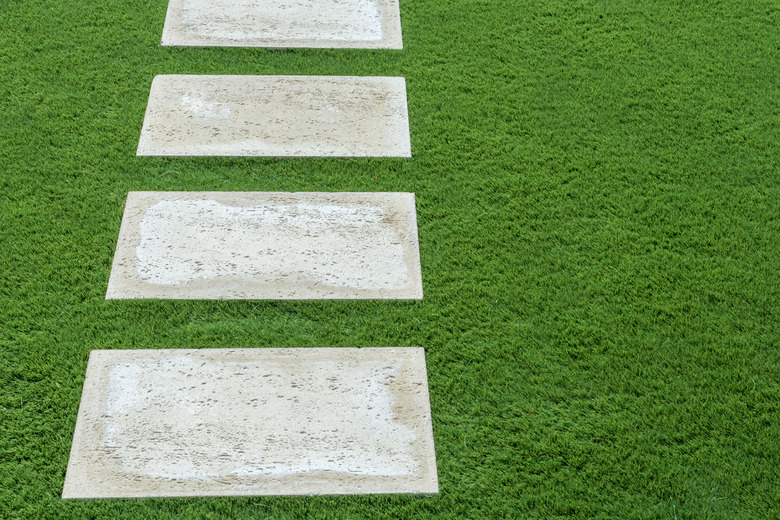How To Lay Paving Stones On Grass
Paving stones, also called pavers or stepping stones, are an effective and attractive way to funnel traffic patterns over grassy lawn areas. You can use paving stones to avoid trampling grass and steer visitors to your garden in a specific direction to show off your garden to its best advantage. Paving stones can be installed on grass in a manner that keeps the paving stone in place and yet makes mowing and trim work easier.
Things Needed
How to Lay Paving Stones on Grass
1. Lay Out the Path
Lay out the pathway with the paving stones by placing the stones directly on the lawn. Create a visually interesting pattern if possible.
2. Test the Spacing
Test your layout by walking from stone to stone with a normal gait. If you find a step is too far or if it feels like you are using too many small steps, adjust the stones so they are closer together or further apart. Walk the pathway many times and make small adjustments as necessary.
3. Cut Around the Stone
Start with the first stone in the series. Put on gloves and safety goggles. Insert a sharp kitchen or garden knife into the turf next to the stone and trace around the stone, cutting or sawing through the turf as you go. Cut all the way around the stone. You may find it easier to use a long-handled half-moon edger that you can step on to cut through the turf.
4. Remove the Turf
Remove the stone. Use a gardener's trowel to remove the turf in the middle of the area. You should be removing turf all the way to the soil, usually in large handfuls that expose the root bundles under the tufts of grass. Save this turf for filling bare spots in your lawn.
5. Compact the Soil
Tamp down the bare soil area with your feel or with a tamping tool. You want to compact the ground under the paving stone. The soil should be compacted enough that when you strike it with your fist, no significant impression is made in the dirt.
6. Add the Sand
Lay down a one-inch deep layer of sand or paver's sand inside the hole. Level the sand using a homemade screed, a small board that you can drag from side to side inside the hole to level the material.
7. Set the Stone
Place the stone into the cut-out area, on top of the sand. Tap the face of the stone with the end of your garden trowel to "set" the stone in the sand. Make sure the stone is level. The top surface of the paving stone should sit about three-quarters of an inch above the ground.
If the top of the paving stone is too low, remove it and add more sand or paving sand to raise the stone to a higher level. If the stone is too high, try to compact it down by tamping on the stone more, or scrape off a little of the sand beneath the stone.
8. Add the Remaining Stones
Repeat this procedure with all the remaining stones along the path, adjusting as needed to make it a smooth, easy-to-walk experience.
9. Fill in Around the Stones
Fill in any gaps between the stones with more sand, loose soil or plugs of the excavated turf. Alternately, dampen the sand and tuck rooted sprigs of a low-growing or creeping plant, such as thyme (Thymus vulgaris, USDA hardiness zones 5-9), Johnny jump-ups (Viola tricolor) or Scotch moss (Sagina subulata, zones 4-8) into the spaces. Press gently so the roots are firmly secured in the sand or soil. Keep moist until the plants are actively growing.
